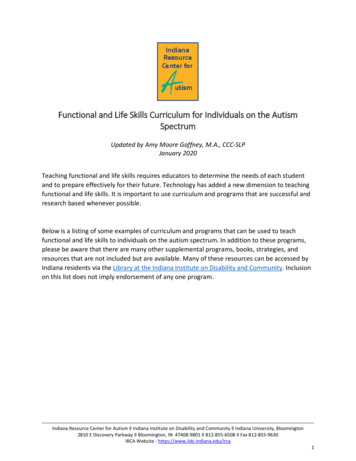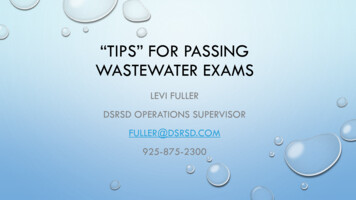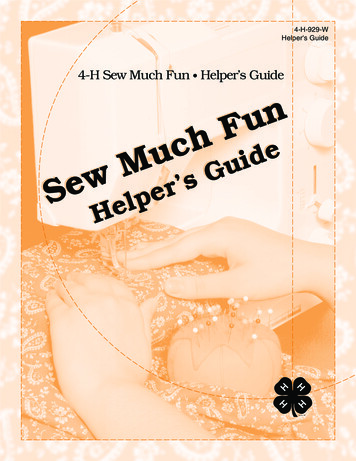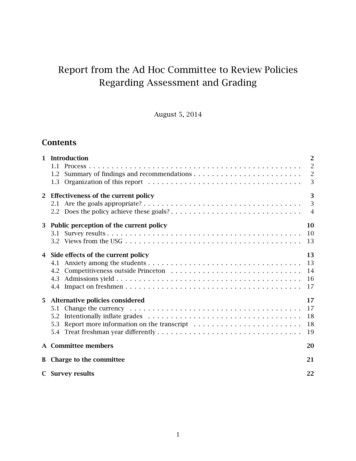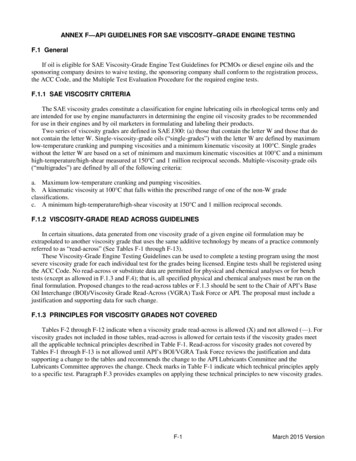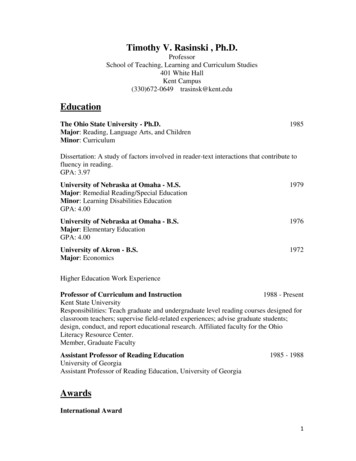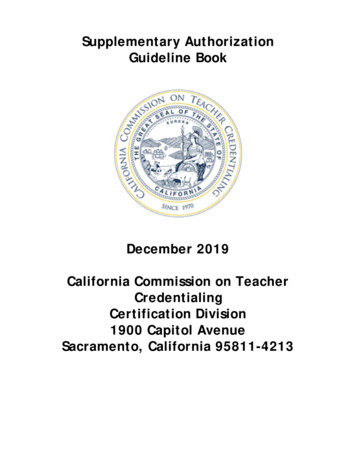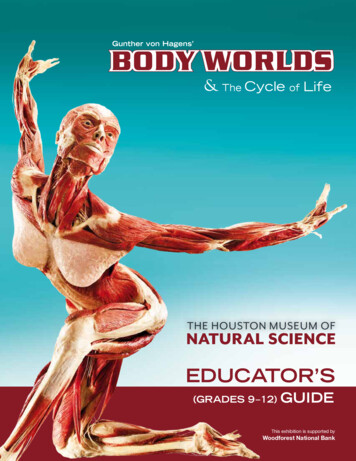
Transcription
EDUCATOR’S(GRADES 9–12)GUIDEThis exhibition is supported byWoodforest National Bank1
EDUCATOR’S(GRADES 9–12)GUIDE
ContentsWelcome Letter .4Planning Your Visit .5Permission Form .6Note to Educators .7Frequently Asked Questions .8Classroom Activities . 11Exhibition Overview including Human Facts . 43Additional Resources . 52This material is protected under copyright laws and may not be reproduced in any mannerwithout the express written permission of the Institute for Plastination.
WelcomeA letter from BODY WORLDSDear Students,Have you ever watched a professional basketball player seem to float in air as he or she leaps up todunk the ball in the basket? Or maybe you watched skiers and skaters competing at the Olympics,and wondered “How did they do that?” Well, our bodies are pretty amazing. And the more we learnabout ourselves and how our bodies work, the better we can take care of ourselves and others. And,the healthier we will be—making us better on the ice rink, basketball or tennis court, jumpinghurdles, or just walking down the street.“Gunther von Hagens’ BODY WORLDS: The Original Exhibition of Real Human Bodies” wasdeveloped by a German doctor and anatomist to help people understand how their bodies work byletting them look inside real human bodies. When you visit with your school or family, you will seeexactly how your brain and your heart look and what happens to them when certain diseases takeover. You will see how smoking destroys your lungs,and how your bones, muscles and ligamentsall work together so you can shoot baskets, dance,or figure skate. The activities inside this guide willhelp you learn more about the human body.Then come visit us to see BODY WORLDS.You’ll really get to know yourself!Dr. Angelina WhalleyConceptual Designer for BODY WORLDS and Managing Directorof the Institute for Plastination4
Planning Your VisitBefore Administer permission forms to parents and guardians (recommended but notrequired) Read the Letter to Educators and Frequently Asked Questions in this guide. Visit the BODY WORLDS website (www.bodyworlds.com) for a preview. It is recommended for teachers to complete pre-visit activities with students suchas those included in this Educator’s Guide. This will help prepare your students forwhat they will encounter within the exhibition. Discuss the visit with students and explain what they are going to see and why.Participate in the activities found in this guide. Please be aware of the recommended chaperone ratio for your groups to optimizetheir experience. We recommend at least one chaperone per 15 students.During Bring the Educator’s Guide with you to the BODY WORLDS exhibition. Seek out HMNS staff for answers to your questions about the exhibition. Please encourage students to leave phones at school/on the bus.After Complete the suggested activities with your students. Consider sharing your students’ reaction to BODY WORLDS. Visit some of the websites listed in the additional resources section.5
Permission FormPlease review this information and share it with the parents and guardians of your students. You may feelfree to use this permission form, but it is not required for admission to the BODY WORLDS exhibition.The BODY WORLDS exhibitions rely on the generosity of body donors, individuals who madedeclarations of will and gave their legal consent that, upon their death, their bodies could be used foreducational purposes in the exhibition. All of the full body plastinates and the majority of thespecimens are from these body donors; some specific specimens that show unusual conditions and thefetuses shown in the prenatal development area stem from old anatomical collections. Most are without skin so you can see the bones, muscles, tendons, nerves, blood vessels andorgans. Eyes and genitals of the bodies remain. Written descriptions accompany specimens. A separate section of the exhibition highlights prenatal development and includes embryosand fetuses. Visitors may choose whether or not to view this area.Parent / Guardian Permission Form:By signing this form, you are acknowledging that your child has permission to view the exhibition witha teacher, school supervisor or other school representative. If you do not wish for your child to see thisexhibition, please ask the teacher to make other arrangements.Yes, I give (student’s name)permission to view the BODY WORLDS exhibition.Parent/Guardian’s name (please print)Parent/Guardian SignatureDate6
Note to EducatorsDear Educator:At the Houston Museum of Natural Science, our mission is to fuse science, technology and art inexperiences that inspire creativity and innovation in people of all ages and backgrounds. BODYWORLDS & the Cycle of Life, provides students and visitors with the opportunity to learn aboutanatomy and health by viewing real, preserved human bodies. This exhibition showcases all our majorbody systems, including our muscular system, nervous system, respiratory system, cardiovascularsystem, digestive system and the reproductive system.BODY WORLDS uses modern plastination technology as a tool to enhance the study of anatomy.Students will understand how the body works when it’s healthy and what happens when it breaksdown, as well as the effects of lifestyle choices on the body. For instance, they can see the effects ofsmoking on the lungs, and how muscles work together during exercise. More than 25 million peoplehave seen BODY WORLDS worldwide.Important information to know about BODY WORLDS: The BODY WORLDS exhibitions rely on the generosity of body donors: individuals who bequeathedthat, upon their death, their bodies could be used for educational purposes in the exhibition. Allof the full-body plastinates and the majority of the specimens are from these body donors; somespecific specimens that show unusual conditions come from anatomical collections. All body specimens are without skin so you can see the bones, muscles, tendons, nerves, bloodvessels and organs. Eyes and genitals of the bodies remain. Written descriptions (English only)accompany all specimens. A separate section of the exhibition highlights prenatal development and includes embryos andfetuses. Visitors may choose whether or not to view this area.7
Frequently Asked QuestionsWhat is BODY WORLDS?The BODY WORLDS exhibitions are first-of-their-kind exhibitions through which visitors learn aboutanatomy, physiology, and health by viewing real human bodies, using an extraordinary process calledPlastination a groundbreaking method for specimen preservation invented by Dr. von Hagens in 1977.Each exhibition features more than 100 real human specimens, including whole-body plastinates,individual organs, organ configurations and transparent body slices. The specimens on display stemfrom the body donation program that Gunther von Hagens established in 1983.The exhibitions also allow visitors to see and better understand the long-term impact of diseases, theeffects of tobacco consumption and the mechanics of artificial supports such as knees and hips. Todate, more than 50 million people around the world have viewed the BODY WORLDS exhibits.What is the purpose of the exhibition?The BODY WORLDS exhibitions aim to educate the public about the inner workings of the human bodyand show the effects of poor health, good health and lifestyle choices. They are also meant to createinterest in and increase knowledge of anatomy and physiology among the public.Couldn’t I learn just as much from books or models of human anatomy?Real human bodies show the details of disease and anatomy that cannot be shown with models. Theyalso allow us to understand how each body has its own unique features, even on the inside. Visitorsare drawn to real specimens in a way that they are not to plastic models. One of the special featuresof museums and science centers is that they offer people a chance to see the real thing in a safe andinformative environment.What is Plastination?Invented by scientist and anatomist Dr. Gunther von Hagens in 1977, Plastination is thegroundbreaking method of halting decomposition and preserving anatomical specimens for scientificand medical education. Plastination is the process of extracting all bodily fluids and soluble fat fromspecimens, replacing them through vacuum forced impregnation with reactive resins and elastomers,and then curing them with light, heat, or certain gases, which give the specimens rigidity andpermanence.8
Where did the specimens on display come from?Will we know who the plastinates are or how they died?The BODY WORLDS exhibitions rely on the generosity of body donors; individuals who bequeathedthat, upon their death, their bodies could be used for educational purposes in the exhibitions.Currently, the Institute for Plastination has a donor roster of 19,000 individuals, more than 2,000are already deceased.All of the whole body plastinates and the majority of the specimens are from these body donors;some specific specimens that show unusual conditions come from old anatomical collections andmorphological institutes. As agreed upon by the body donors, their identities and causes of deathare not provided. The exhibitions focuse on the nature of our bodies, not on providing personalinformation.Why are the plastinates posed the way they are?The poses of the plastinates have been carefully thought out and serve educational aims. Eachplastinate is posed to illustrate different anatomical features. For instance, the athletic poses illustratethe use of muscle systems while playing sports. The poses allow the visitor to relate the plastinate tohis or her own body.Will I be able to touch any of the plastinates?While you will be able to get very close to the plastinates, as a rule, visitors are not allowed to touchthem. At a certain area in the exhibition, however, visitors have the option of touching a select group ofplastinated organs to better understand both the human anatomy and the process of Plastination.Are these exhibitions appropriate for children?More than 50 million people, including young children, have viewed the BODY WORLDS exhibitionsaround the world. It is important to note that the exhibition includes full-body plastinates withexposed genitals.We recommend the BODY WORLDS exhibits for school groups in Grades 5 and up.9
Why is it important for the public to see these exhibits?We believe that when people understand more about how the body works and how it can break down,they are more likely to choose healthy and sustainable lifestyles. We also hope it will inspire visitorsto learn more about the life sciences. Knowledge about what the human body looks like and how itfunctions is basic life science information that should be available to everyone.How long can I stay inside the exhibits?You can stay as long as you like. But we recommend allowing yourself about one to two hours. Thelength of time will vary on how long each visitor wishes to examine each specimen and read theinformation provided. An audio tour will increase your time in the exhibits.Can I take photographs or film in the exhibitions?Photography and filming with small devices may be allowed at certain exhibitions, please inquireonsite. Flash, commercial and professional photography are not permitted. Photography that isdistracting to other visitors may be stopped at any time.Are food and drink permitted in BODY WORLDS?Food and drink are not permitted in the exhibit galleries. The policy helps to protect HMNS’ exhibits,as well as the BODY WORLDS plastinates.10
Classroom ActivitiesThis sampling of classroom activities, taken from the BODY WORLDS CD-ROM of ClassroomActivities, can be used as either pre-visit activities to prepare students for BODY WORLDS or aspost-visit activities to help debrief them.Someone you know as a Plastinate1. Look carefully at the positions of those quoted below .2. Which arguments can be used respectively for and against the BODY WORLDS exhibition?3. Are the arguments conclusive? (Test them if necessary by drawing on further reading.)4. Consider what motivates a donor to allow his body to be plastinated for an exhibition.5. Consider how the friends and relatives of the donor feel.Positions of visitors and non-visitors1“What tastelessness and irreverence will people come up with next to “get rich quick”? Can theynot imagine how the friends and relatives of the deceased feel? But I think that Gunther von Hagensunderstands nothing of “sympathy”, and “stopping at nothing”. As can be judged by the 780,000visitors at Mannheim, there are enough sheep everywhere to go along with him. I would advise thesepeople and the exhibitors, if they are so curious to see dead bodies, to go into war zones.”Gertrud Holzki, Cologne“I think that the exhibition is simply fantastic because it teaches us about the inner anatomy ofthe human body. You can read a hundred books on anatomy and look at hundreds of pictures,but how the organs really look, and where and how they are positioned, can only be seen in thisgenuinely fascinating exhibition. I also think that it‘ s great that bodies can be conserved for avery, very long time in this way. This is useful for training doctors or even enlightening us, the laypeople. We can see ourselves in the plastinates.”Rita Gilberg, Koblenz11
“I do not think that it is educational because the bodies are not displayed in natural positions.The way Hagens does it, it‘ s not physiologically correct. The people are not just taken apart, butthe layers are pulled apart. Afterwards we don‘t know what the body really looks like from inside.Reality is distorted, and the people are only put on show. This exhibition is about voyeurism, and ithas nothing to do with striving after medical knowledge.”Daniela Klinger, Cologne“I don’t agree with the statement that BODY WORLDS is a corpse show. It is a great credit topeople when they put themselves at the disposal of science after their deaths. Perhaps thisexhibition will cause an increased respect towards service to humans, as offered by doctors,nursing staff or the fire brigade.”Silke Ebert, Cologne“I am looking forward to this exhibition a lot. Even as a child I looked up in the encyclopedia whatpeople look like from inside. I also watch operations on the television for hours at a time. I findit totally fascinating. And the horror effect of a show like this is surely the same as looking at acathedral crypt in which a dead bishop is buried.”Sascha Arnz (German TV Producer, “Wetten, dass . ?”)“If respect for the dead is maintained in the display, I find it very interesting. I will definitely beviewing the exhibition. I hope that it will cause people to change their attitude towards the bodyand perhaps treat it a little better, when they see how often it is abused. A little shock like that cansometimes be helpful. ”Joey Kelly (“Kelly Family”)“No, I am not going to the exhibition. Because death is not for use as a kind of trendy exhibitionism.I see this unsuccessful attempt at obscenely making eternal what is transient as nothing more thangrave-robbing and show-business with horror under the pretext of breaking down taboos.”Günter Wallraff, author“I find an exhibition like this unnecessary. There are enough cut-up bodies, even cross-sections ofbodies, for the medically-inclined to see in the anatomical institutes of university clinics. A corpseshow like this does nothing for art. It just adds to the horror factor. I don’t need to see it.”Heinz Zolper, Cologne-based painter who designed the title pageof the millennium edition of EXPRESS newspaper12
Other views: The artist himselfThe artist: The popes started itCologne—19 days to go until Gunther von Hagens’ grisly plastinated corpses hit the Haymarket.EXPRESS spoke to the “plastinator”.EXPRESS:Herr von Hagens, do you fear for your soul?G. v. Hagens: No, why?EXPRESS:Because the Church makes you out to be the devil.G. v. Hagens: I just don’t understand it. If I were the dean of a cathedral, I’d say: “Go forth andmarvel at the wonders of human creation!” And anyway, my exhibition is in the bestChristian tradition.EXPRESS:“Robbing the dead at the Haymarket” is in the Christian tradition?G. v. Hagens: Almost—in the Middle Ages the popes themselves offered their bodies for dissection.Christianity is by far the most anatomy-friendly religion.EXPRESS:But your love of anatomy is now going before the courts.G. v. Hagens: They have already tried that in Mannheim.The public prosecutor took a good look at everything.EXPRESS:And?G. v. Hagens: He didn’t admit the charge because under law I don’t have bodies, but specimens.Otherwise I would need corpse transport permits for all the specimens.EXPRESS:There just wouldn’t be this sort of trouble with plastic specimens.G. v. Hagens: But then nobody would come. A Louvre full of copies wouldn’t interest anyone either.13
EXPRESS:But why do you need so much attention? What do they show that plastic doesn’t?G. v. Hagens: I want to give the body back to the layman. I want Grandma to say after the exhibition“Now I know why the surgeon took five hours over my hip.”EXPRESS:Sure, but Grandma would also get the point with plastic.G. v. Hagens: But this gives another level of credibility. Here it isn’t possible to fake anything.Besides, I also want death to become something normal again.EXPRESS:So what do we get out of this ?G. v. Hagens: Studies have shown that people leave the exhibition with a greater awareness of the body.To achieve that, I need real bodies.EXPRESS:How many exactly?G. v. Hagens: At the Haymarket exhibition, there were 30 donated bodies on display .EXPRESS:Too many. After halfway through the Basel exhibition, nothing was new any more.How many sliced-up bodies does a person need?G. v. Hagens: Then maybe you just weren’t looking carefully enough.EXPRESS:.it’s possible. In the end I’m only a layman too.G. v. Hagens: .we have built display cases for the eight organ systems. And still we get visitors sayingto us, “We want more specimens”. Of gastroscopy and so on.EXPRESS:Will you let yourself be plastinated after your death?G. v. Hagens: Of course. Otherwise everything I’m saying to you here would be rubbish.14
Other views: A representative of the ChurchBODY WORLDS now threatened by lawsuit—Church castigates “freak show”3Cologne—The plastinated corpses arrive at the Haymarket on 12 Februar y. No art exhibition has everdivided Cologne as much as BODY WORLDS. Is it all a question of taste? The Church says “no!”—andhas declared war against the “plastinator”, Gunther von Hagens. This exhibition has to be stopped—inthat, Catholics and Protestants are agreed—even, if necessar y, through the courts.“We are considering taking legal action against it”, the archbishop’s spokesman Manfred BeckerHubertitold EXPRESS. “The exhibition is nothing but a freak show.” Eckart Schubert, Superintendent of theProtestant Church, has an idea of how to put a stop to the plastinator’s work. “He does not havepermission to bring the corpses in. The majority are said to come from Kyrgyzstan and China.” But“you need corpse transport permits to take the dead across borders. And he didn’t have those.” TheChurches make further claims: It is not at all clear whether this freak show is permissible under law.Besides, says Schubert, “the donors who have had their bodies plastinated cannot exactly makedecisions about their own bodies.” For “a corpse has to be buried. The only exception is when the bodyhas been donated to science.”The plastinator ’s argument, that the exhibition of corpses at last gives an insight into the human body,holds no water with the men of the Church. For them, what the pathologist Gunther von Hagens isdoing is merely “robbing corpses”. “What we see happening at BODY WORLDS is exactly the same aswhat could be seen at a “House of Monstrosities” at a 19th century funfair. There, there was a womanwith no abdomen, a child with two heads,” thinks Becker-Huberti.The Protestant Church goes yet one step further, comparing the controversial exhibition with horrorvideos. “Real bodies, brutally chopped up—that promises a bit of a kick.”The Catholic and Protestant Churches now want to reach agreement on whether the subject ofBODY WORLDS should be raised in church services, and whether circulars should be sent roundto parishioners. “There is one thing you have to understand. Here, people are making money bydismembering human beings and putting them on display,” says Schubert. “It is voyeurism and profitmongering.”15
Other views: A doctorFar from the dripping preparation tables. With plastinates, anatomy has come alive4Wiesbaden—Running, fencing, playing chess—it’ s amazing what corpses can do. Quite possiblythings they were unable to do in life. Does BODY WORLDS show art, then, or science? Should we seeplastination as a particular kind of preparation technique or as creative craftwork? “For me, plastinatesare not works of art, as they were created with the specific aim of imparting anatomical knowledge,”is Gunther von Hagens’ line on this much-debated issue. Indeed, he sees art, unlike science, asbeing without purpose. “If the concept of the artist is not exaggerated in the Beuysian sense, thenthe plastinator is a craftsman, but not an artist.” And this is how Gunther von Hagens argues hispoint when, again and again, his plastinated fi gures are described as works of art. “Modern art is aconceptthat relies on interpretation. So each person reads his own motivation into my endeavours, amotivation that is a product of an artistic and moral viewpoint that is entirely his own.” This is why , athis exhibition, Gunther von Hagens likes to speak of “anatomical art”, precisely because he wants hiswork to be seen both as an exhibit and as craftsmanship.Prostrate corpses do not achieve anythingFrom the perspective of its inventor, what has plastination changed in medicine, in university levelstudy? “The anatomy of a corpse is in itself completely uninteresting,” says Gunther von Hagens. “Itis only important because through it you can study the anatomy of the living, albeit in a limited way.Whereas, since Vesal’s work in the Renaissance, human skeletons have stood upright, the wet, drippinganatomy corpses have to stay on the preparation table. Here, either their front or back is always hiddenfrom the researcher’s gaze, so they can never be fully demonstrated.” “Living anatomy” is clearlythe trend of the day. As a student at the swimming pool, says Gunther von Hagens, he had problemsfollowing the advice of his anatomy professor to make the connection between the pleasing side of thebody (aesthetic people-watching) and the useful (the study of surface anatomy). The difference betweenthe stiff, prostrate corpse on the preparation table and the play of the muscles of swimming, runningand sitting people was always too great.Students size each other upToday, in their favourite subject, “living anatomy”, students are sizing each other up, mapping anddrawing the muscles and organs onto each others’ skin. And, as Gunther von Hagens sees again andagain, they love it. For him, one thing is certain: “The layman in medicine, which includes the studentof medicine who is just starting out, is not interested in the anatomy of the dead. Because a friend,their sexual partner or, after all, the patient that budding doctors will later treat is alive, moves, strikesposes. So in this respect it is only logical that whole-body plastinates should be positioned upright,true-to-life, to impart their information in the habitat in which they lived.”16
DigestionIntroduction to the subjectA significant part of our food consists of macromolecules that are insoluble in water. In digestionthey are broken down, using water, into compounds that are largely water-soluble. They can then bereabsorbed by the intestinal wall and transported through the body in the bloodstream and lymphaticsystem. Through this breakdown the nutrients, particularly proteins, also lose their specific structure sothat no foreign protein enters the bloodstream.In digestion:Proteins are broken down into amino acidsCarbohydrates are broken down into monosaccharidesFats are broken down into glycerine and fatty acidsFor the most part, this breakdown does not occur directly. Instead, it takes place in a series ofinterim stages involving various complementary enzymes. Vitamins, most inorganic ions and water areabsorbed by the body in their original form. Digestive juices form in the glands of the digestive organs.The active components of these digestive juices are enzymes.In the following experiments, the following enzymes are used: α-amylase, pepsin and pancreatin.α-AmylaseThis enzyme breaks starch (amylum) down into maltose:Starch Waterα-AmylaseMaltoseThe enzyme attacks the middle part of the starch molecule. At first, this produces larger fragments.But these only last a short time. Very quickly the disaccharide maltose is formed. In the body, amylaseis found in particular in saliva and pancreatic juices.Picture 1: In the polysaccharide starch, cyclic molecules ofthe monosaccharide glucose form a long chain that coils upinto a helix.Picture 2: In proteins, a number of amino acids combineinto a chain, which then forms a spiral-shaped coil.17
PepsinPepsin is a major component of gastric juices. Its precursor form, pepsinogen, is produced by thechief cells of the gastric fundus. The fundus cells secrete the pepsinogen into the stomach. Underthe influence of gastricacid, the pepsinogen is activated as the active enzyme pepsin. In these acidicconditions the pepsinogen divides into pepsin and a number of peptides. One of the peptides thatseparates off acts as an inhibitor. In the neutral reaction of digestive juices, it is taken up by pepsinand blocks its action. But in acidic pH conditions the pepsin inhibitor complex divides. The pepsincan now exhibit its enzyme action. Pepsin attacks the protein molecules in the vicinity of the aminoacids tyrosine and phenylalanine. This way, only approx. 10% of the peptide bonds in a proteinmolecule are broken. As part of this process, a mixture of peptides of various chain lengths (molecularmass: approx. 600 – 3000) is formed, as well as a small amount of amino acids.PancreatinThis preparation contains those enzymes in the pancreatic juices whose optimal pH is in neutral toweak alkaline conditions. The principal components of pancreatin are :-Amylase: divides starches (see above)Proteases: Enzymes that break proteins down to amino acidsProtein Water Amino AcidsLipases: divide fats into fatty acids and glycerineFat Water Fatty acids GlycerineMost of the experiments we describe below are test tube experiments that can be carried out withoutmuch expensive apparatus. While in many cases it is useful to have a chemical oven (temperature37 C), this is by no means essential. There is also no need for a set of scales as long as you take careto ensure that, in comparative tests, the same amounts of substance are used. The measure “a spoontip’s worth” is meant to indicate the amount of solid that would fit on the last 2cm of a spatula.Instructionsfor storing the enzymes:If left in a dry place in the fridge( 4 C), the enzyme preparationswill keep for several years withoutany significant decrease in sctivity.18
In the descriptions below, we have only included experiments that are quick to do and are thereforewell-suited to demonstrations. However, it is often unavoidable that results—particularly those relatingto protein digestion—can only be seen after one or several hours (if egg white is used). Suppliesfor many of these experiments are readily available online. We suggest Science Lab Supplies (www.sciencelabsupplies.com) and Carolina Biological (www.carolina.com).EXPERIMENT:Digestion of FatMaterials:Cooking oil, pancreatin, dilute sodium hydroxide, phenolphthalein solution.Test tubes, beakers, 1 Erlenmeyer flask with airtight stopper,300ml (or larger), measuring pipette (e.g. 5 ml).Preparation:I. Fill each of 2 test tubes with the same amount of water (approx. 5ml).Put approx. 50 mg (1 “spoon tip’s worth”) of pancreatin into one of these test tubes and shake into asuspension.II. Put approx. 200 ml of water and approx. 2ml of cooking oil into an Erlenmeyer flask.Seal the flask and shake it vigorously until an opaque milky liquid forms.Add 5 drops of dilute sodium hydroxide and 5 drops of phenolphthalein solution to this emulsion,while swirling the flask. The liquid is now a pink colour .Method:Divide the fat emulsion (II) equally between 2 beakers.Add the pancreatin suspension (I) to one of the beakers.For comparison, add only an equivalent amount of water to the second beaker .Observations:After a short time the contents of the fi rst beaker become colourless, whereas no change can be seenin the second beaker .Explanation:Pancreatin contains the enzyme lipase, which breaks up fat. The free fatty acids that result fromthe process neutralise the sodium hydroxide. In neutral and acidic conditions, phenolphthalein iscolourless.1 Gunther von Hagens: “Anatomy and Plastination”. See also Catalogue p. 28-3019
EXPERIMENT:How Bile WorksMaterials:Cooking oil, dried ox bile, 2 test tubes, 2 shallow dishes (e.g.
anatomy and health by viewing real, preserved human bodies. This exhibition showcases all our major body systems, including our muscular system, nervous system, respiratory system, cardiovascular system, digestive system and the reproductive system. BODY WORLDS uses modern plastination technology as a tool to enhance the study of anatomy.
